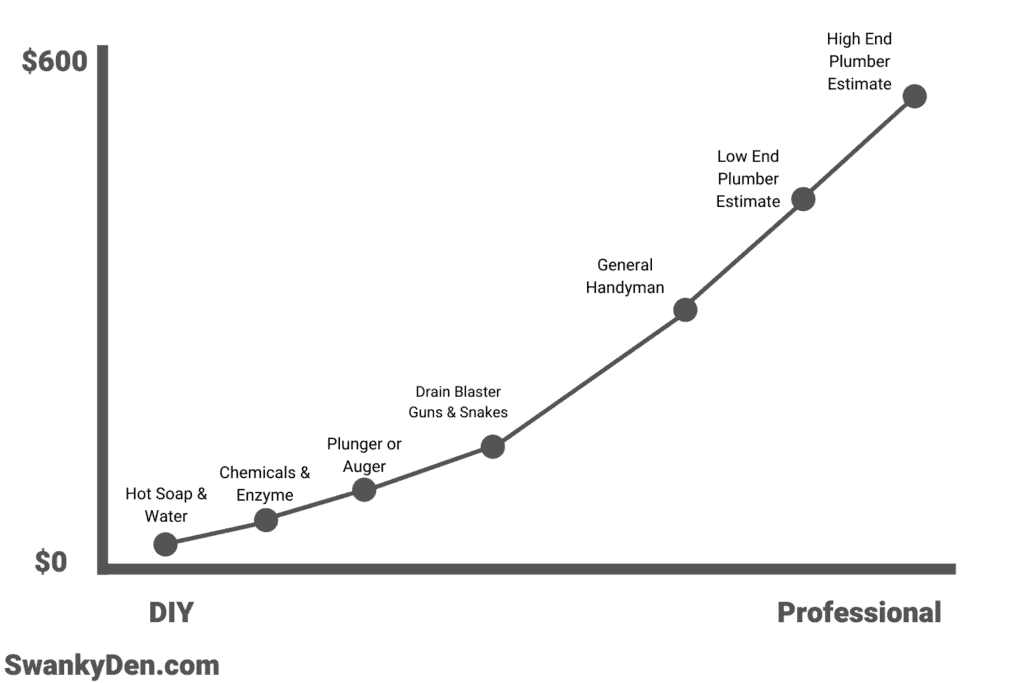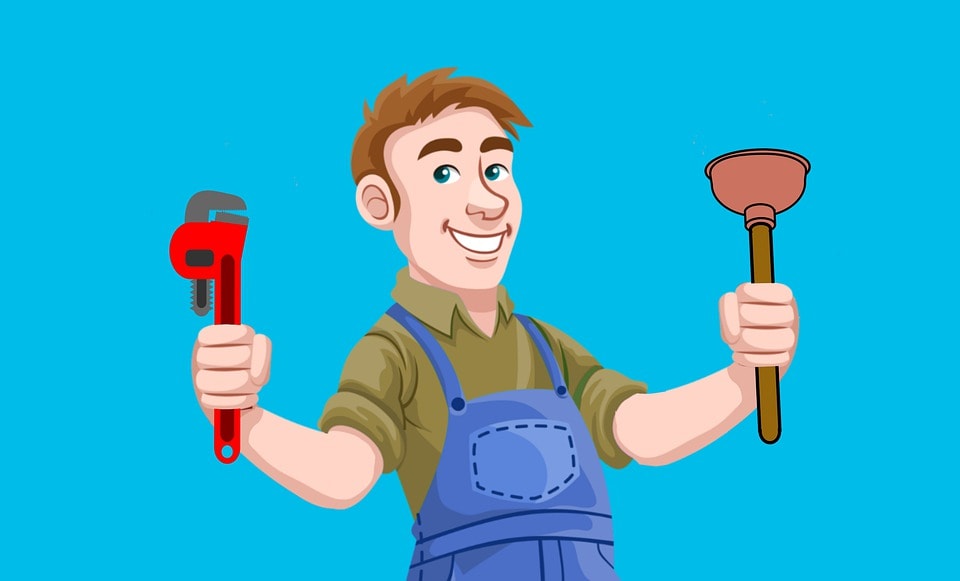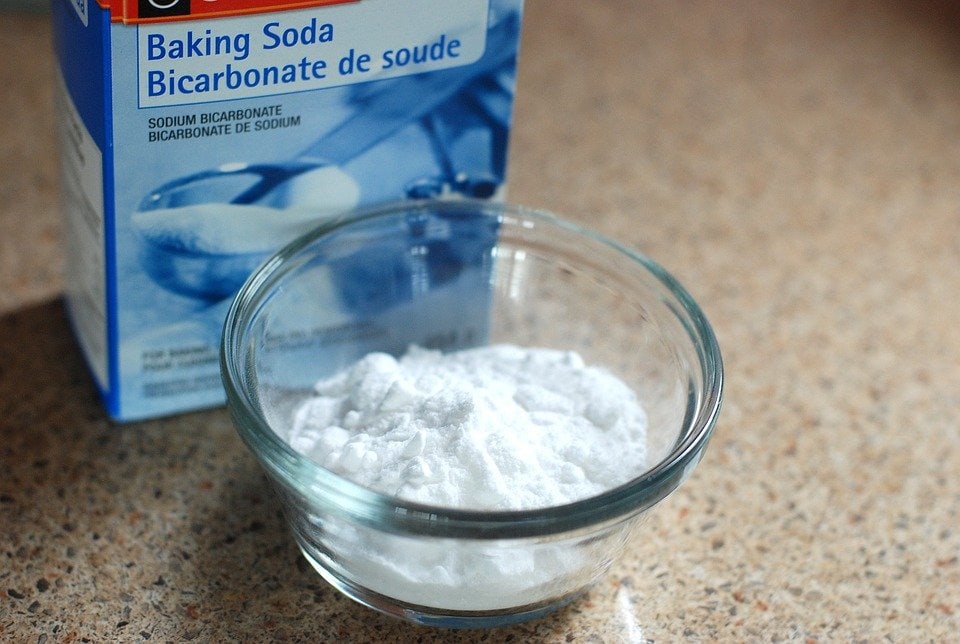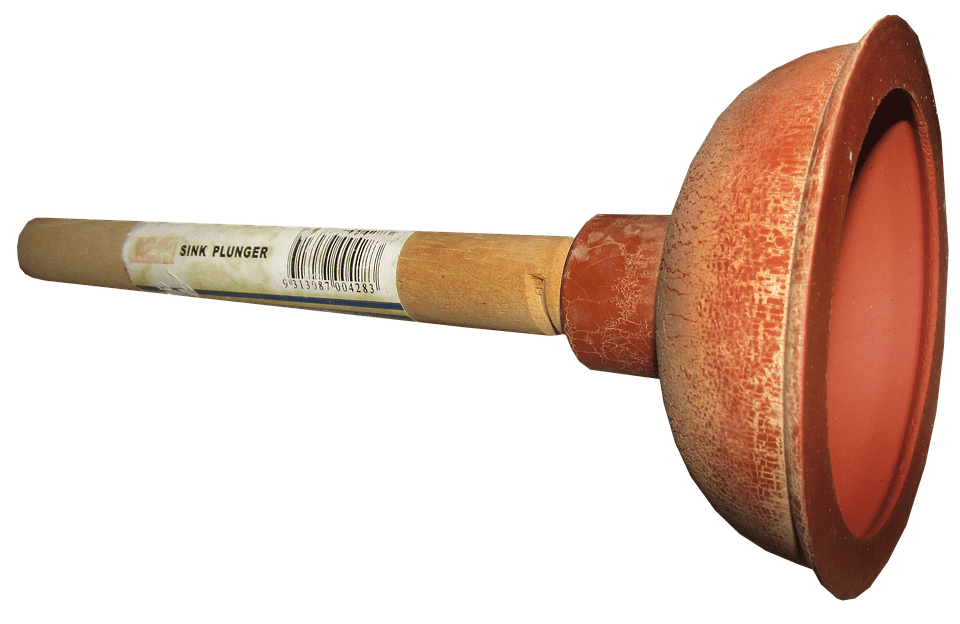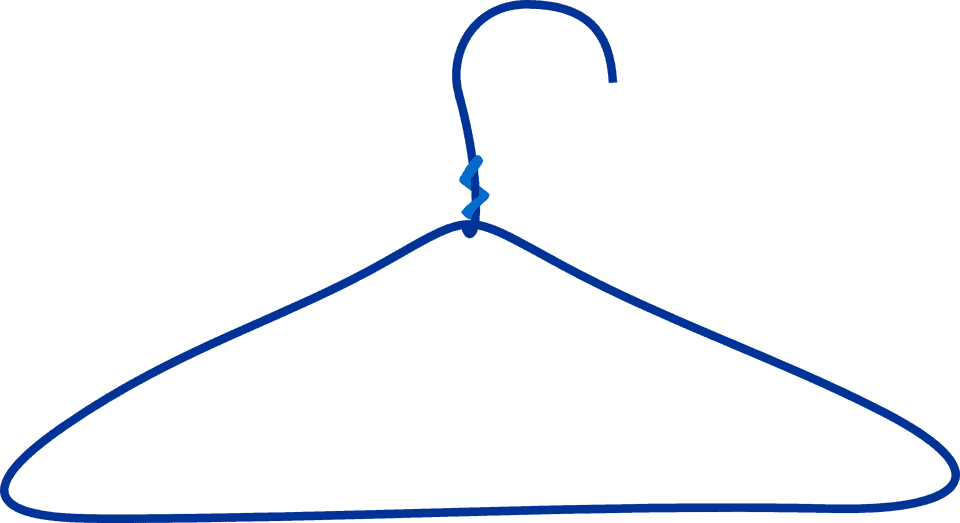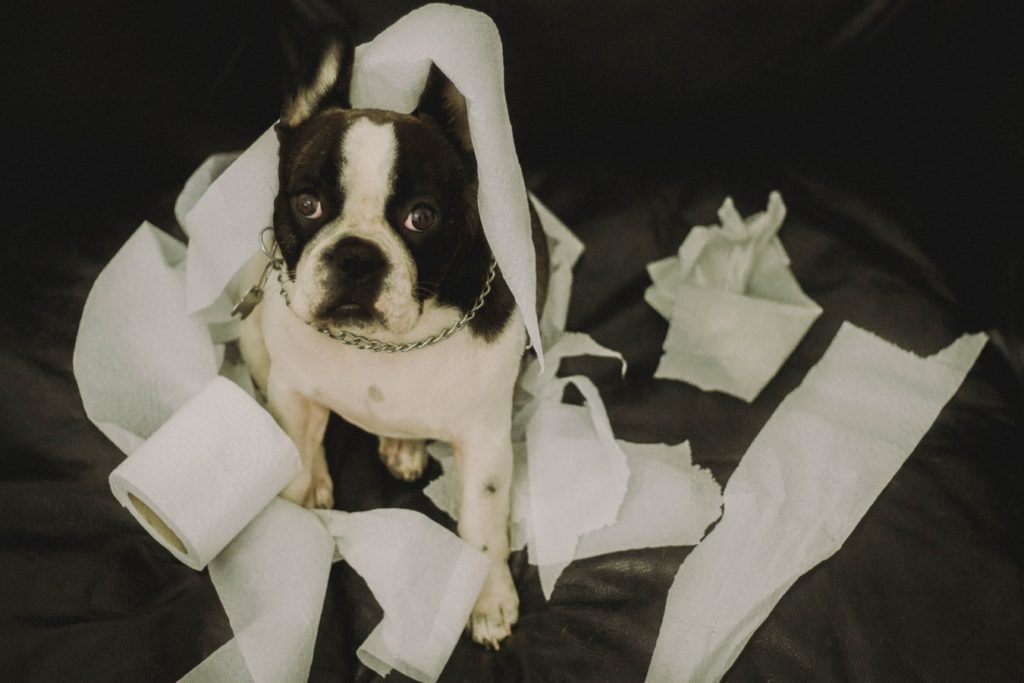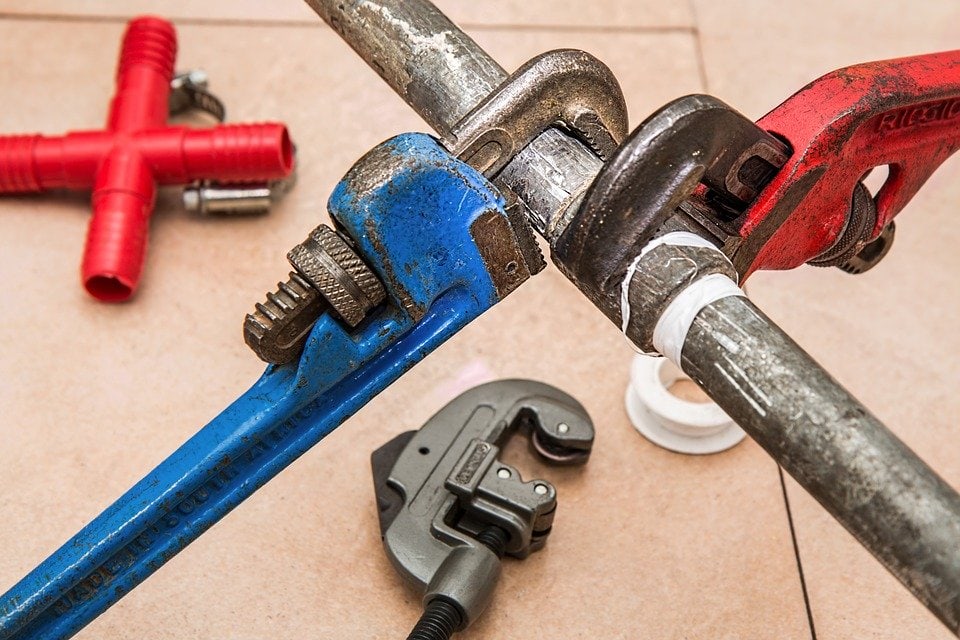A clogged toilet can cause anything from expensive damage to pipes to emotional scars from embarrassment. However, most toilet clogs are preventable. So let’s save the money and scarring— hopefully— for another time and get down to toilet unclogging and prevention business.
In This Article We'll Discuss
DIY Vs Professional Cost to Unclog a Toilet
Thinking about calling a plumber? Some problems do call for a professional but one look at this chart and it’s easy to see how much the costs rises to call someone in.
Keep on reading to determine if you can save money by fixing this yourself wether you have a large toilet or a small compact toilet in your bathroom.
Table of Contents
How to Unclog a Toilet Steps
Stop the Flow
The first thing you that must be done is to keep the toilet from overflowing. If after the first flush the toilet won’t properly drain, don’t flush again. Take off the toilet tank and close the toilet flapper. This will keep more water from entering the bowl and causing it to overflow.
The water in the tank is separate from the bowl so don’t worry about it being dirty. A flapper is circular and looks like a drain stopper. It is attached to the chain. Press down on the this to stop the water from filling the bowl
Prep The Bathroom Floor
Unclogging a toilet can get messy so prep the area using paper towels or newspapper. You’ll thank yourself later. If you have a window in your bathroom keep it open. Also, turn on the vent. This will help with any bad odors.
Don’t forget to put on a pair of rubber gloves on and make sure you’re not wearing your favorite clothes. Toilet unclogging can get messy.
Inspect The Clog
Before you reach for your plunger, take a peek inside the bowl. If you have kids or pets in the house the obstruction can be caused by a toy or ball that fell inside. Reaching inside and dislodging it with gloves is all you have to do.
It’s important to take these key steps before moving on to make sure you can unclog the toilet on your own. You’ll also want to prep to reduce the mess you’ll make.
Loosen The Clog
You’ve officially prepped the area and you’ve determined there isn’t any obvious obstruction to remove with gloves. Let’s make the not so fun easier by loosening what’s causing your dilemma.
A Plumbers Trick
Hot water and dish soap or detergent go a long way in breaking up toilet obstructions. Mix some hot water with soap and pour it into your toilet bowl.
The heat and soap work together to make it much easier to use a plunger. You should let it sit for 10-15 minutes. It’s possible that this solution will be able you need to unclog the toilet.
Going Natural with Vinegar and Baking Soda
One more thing to try before reaching for the plunger is this trusty old trick. It seems like baking soda and vinegar is the solution for anything home related.
Pour baking soda and vinegar into the toilet bowl. The chemical reaction will work to break down the clog and make life easier when plunging. Again, this may be all you need to remove the clog.
How to Unclog a Toilet With a Plunger
With the two methods used to loosen the toilet clog we are ready to remove all but the toughest obstructions. Get your plunger out and make sure it isn’t stiff from being stored for long periods of time.
Running hot water on the plunger and pressing down on it will prep it. A tight seal on the toilet bowl is necessary for the plunger to work.
Put the plunger in the bowl and do your best to form a seal over the hole. You will be using downward pushes and pulls to dislodge. Make sure you put as much effort pulling on the plunger as pushing in.
You may have to keep adding water to the toilet bowl as some is needed to ensure a tight seal. Halfway full is sufficient.
You’ll know success has been reached when the water starts draining from the bowl. If this happens, flush the toilet and make sure it’s working properly. Does the bowl start over flowing again? Press down on the flapper once more to prevent water flowing.
Repeat this process a few more times until the clog is gone. If the toilet is still clogged, fear not as we have a method for the most stubborn clogs.
Loosening the clog and using a plunger will take you through most situations. If you repeated the process a few times you’ll need to move on to other measures.
How To Unclog With a Toilet Auger or Plumbing Snake
You’ve tried all other methods, the toilet is still clogged, and you’re not ready to call it quits. Fear not as there is one method left (besides calling the plumber). It’s time to use a toilet auger— a strange device most have never heard of.
What is a toilet auger? It’s a long tube with a bauble at the end used to unclog toilets and pipes. Don’t confuse them with a drain snake, which are used to unclog sinks and not toilets. An auger is heavy duty and longer than a drain snake.If you are shopping for an auger, make sure you get one specifically for toilets. If it’s not it can damage your toilet or simply won’t work.
(refer to the top of this blog post for steps on preparing before using the toilet auger including having gloves on and clothes you’re not worried about dirtying)
1. Insert the toilet auger into the bowl
You’ll need to pull the handle all the way up so that the cable is close to the end of the tube. The curve at the base of the tube makes it easier to insert it down the toilet bow.
There is a rubber or plastic coating on the bottom to prevent scratching the porcelain on the toilet. You’ll know it’s properly inserted when you don’t see the cable—you’ll only see the tube you’re holding into the toilet bowl.
2. Crank the auger into the clog.
The auger will work using rotation so that the cable goes deeper into the drain. Toilet clogs, most of the time, occur in the upper section of the drain pipe. The auger has enough length to clear past this point and can go as far as the soil tank.
The auger will solve most clogs but if it lies beyond this point you’ll have to resort to other methods to unclog the toilet.
3. Hold the auger housing to keep it in place and crank back and forth
Be slow and patient while cranking the auger handle back and forth. This will work it through the clog slowly–and safely— clearing it.
To ensure you reach the clog, rotate the cable out until it goes no further. Once it’s fully extended crank it back all the way out and repeat this a few times. The toilet will begin to drain once the clog is removed. To be safe repeat a few times to ensure all debris is removed.
When you’re done clean the auger and dry it. If you leave it wet it may rust.
How To Unclog a Toilet With a Coat Hanger
Wouldn’t it be wonderful if all the tools you needed were just readily available? Well this is life and we all know that’s not how it works. But of course, as humans we always find solutions. This time a coat hanger–which should be in all homes— will put our ingenuity to the test.
1. Unravel the coat hanger and straighten it out
Use some pliers to unravel the wire and straighten it out. Tie a rage towards the end of the hanger to ensure you don’t scratch the toilet. Duct tape is good for this or a rubber band.
To be honest this method is only going to work if the obstruction is close to the front of the toilet drain.
2. Work the hanger in and out of the toilet
Make sure you have gloves on so you can reach as deep as possible. Some splashing of tainted water may happen while you’re working the hanger. As you reach in with the hanger, if you can’t feel the obstruction then it is further down and you’ll have to use another method.
3. Flush the toilet and check it doesn’t overfill again
You’ll know you’ve succeeded once the toilet bowl starts to drain. If you flush the toilet it should drain completely. A bowl that is slow to drain or clogs again means that the obstruction wasn’t fully removed.
Unclog a Toilet With a Drain Cleaner or Enzyme Waste Removal Product
1. Purchase a chemical drain cleaner or enzyme removal product.
You can find these products online, at home improvement stores, or grocery stores. An enzyme product is designed to break down waste. For stubborn clogs you can use it together with a plunger. These methods won’t work if the obstruction is caused by toys or non organic waste objects.
2. Follow the instructions on the product.
The instruction label will let you know how much of the product you should pour in and what actions to take after pouring the product into the toilet bowl. They will take up to one day to work and you won’t be able to flush the toilet during that time.
The toilet will drain if the product has worked.
How do Toilets Get Clogged
Every home has a toilet and like everything else in the home it won’t work perfectly forever. A clogged toilet can lead to very unpleasant experience–and a very unpleasant cleanup. Knowing how a toilet gets clogged will help save you from some frustrating days for you and your family.
1. You have an old low-flow toilet
To conserve water–and save the planet—new technology was used to lower the amount of water used by toilets. The early forms or low flow toilets occasionally lacked the pressure needed to thoroughly flush through the drain pipes.
Toilets made in the mid 1990s can have this issue. Try to avoid over using toilet paper and avoid clog causing items like flushable wipes. If this doesn’t help your only solution will be to replace the toilet.
2. A non flushable item has been flushed
So many items like feminine products and flushable wipes,which seem to be flush friendly, can cause clogs. The only things meant to flushed down a toilet are organic waste and toilet paper.
Paper towels and facial tissues are not. If you have children speak to them about what is okay and not okay to flush down the toilet. An easily visible trash can helps avoid improper flushing.
3. Check Your Plumbing Vent
Newer plumbing fixtures and toilet can use a vent in the roof to help with the drain flow of your home. These vent can get blocked with leaves and sticks. Sometimes animals can build nests or drop debris on them as well.
A toilet vent that has been blocked will reduce the flow of your drain over time. This will lead to clogs. For this situation a professional is recommended as it can be hard to fix as special tools are required.
4. Is The Main Sewer Line The Problem?
This is a situation that will be difficult if not impossible to fix on your own. Waste can cause clogs in the upper areas of your toilet drain as well as deep inside that require special tools to reach.
Main sewer clogs are not easy to reach and you need to call a professional to solve this problem. If none of the other toilet clogging issues are causing your blockage then this will be the problem.
When Should I Call The Plumber?
You can put all your efforts in unclogging your toilet and have no success. So, now that you’ve tried everything, is it time to call the plumber?
All the methods we’ve gone over are ways you can remove a toilet clog but if you haven’t had success it’s time to call the plumber. Another reason is if you see unusual water back up after flushing the toilet. This would be seen water coming up your bathroom sinks or shower.
How To Prevent Toilet Clogs
Preventing a toilet clog comes down to reviewing the reasons for a toilet clog with your family. If you have kids in the home, teach them what is okay to put in the toilet and what isn’t— no, it’s not a toy jacuzzi.
Some think it’s okay to flush paper towels, facial tissues, and feminine products down the toilet so review that it is not. Make a trash can easily visible and available in the bathroom.
Keeping up with weekly toilet cleaning will also prevent clogs. Gunk blocked the water jets in the rim of the toilet will reduce flush strength and cause clogs over time.
Wrapping Up How To Unclog a Toilet And Prevent Future Clogs
Now that you’ve read this you’re a toilet unclogging professional. It’s time to let your home know how to prevent this scary mistake in the future and enjoy a well flushing toilet.
Did you find this article helpful? Is there anything else you’d like to know? Please let us know in the comments below.


